Related Research Articles

Jeholopterus was a small anurognathid pterosaur known from the Middle to Late Jurassic Daohugou Beds of the Tiaojishan Formation of Inner Mongolia, China, and possibly the Early Cretaceous Sinuiju Formation of North Korea.
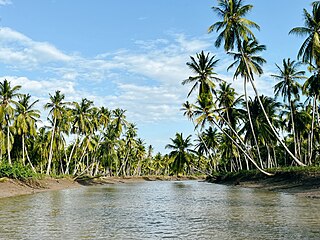
Pangani District Council is one of eleven administrative districts of Tanga Region in Tanzania. The District covers an area of 1,756 km2 (678 sq mi). It is bordered to the north by Muheza District, to the east by Zanzibar Channel, to the south by the Chalinze District of Pwani Region, and to the west by the Handeni District. The district is comparable in size to the land area of Guadeloupe. The district seat (capital) and largest settlement in Pangani district is the town of Pangani. The district is named after the historic Pangani River. As of the 2022 census, the population was Pangani district was 75,642, making it the least populous district in Tanga Region.

Tanga Region is one of Tanzania's 31 administrative regions. The region covers an area of 26,667 km2 (10,296 sq mi). The region is comparable in size to the combined land area of the nation state of Burundi. The regional capital is the municipality of Tanga city. Located in northeast Tanzania, the region is bordered by Kenya and Kilimanjaro Region to the north; Manyara Region to the west; and Morogoro and Pwani Regions to the south. It has a coastline to the east with the Indian Ocean. According to the 2022 national census, the region had a population of 2,615,597.

Anurognathus is an extinct genus of small pterosaur from the Late Jurassic Altmühltal Formation of Germany.

Muheza District, officially the, Muheza District Council is one of eleven administrative districts of Tanga Region in Tanzania. The District covers an area of 1,498 km2 (578 sq mi). It is bordered to the north by Mkinga District, to the east by Tanga and the Indian Ocean, to the south by the Pangani District and Handeni District, and to the west by the Korogwe District. The district is comparable in size to the land area of Guadeloupe. The town of Muheza, after which the district is named, serves as its administrative capital. According to the 2012 Tanzania National Census, the population of Muheza District had decreased to 238,260; this is less than ten years before, because Mkinga District was created that same year. The highest point in Muheza District is Kimbo Peak at 1,063m.

The Amboni Caves are a limestone cave complex in East Africa. They are located in Kiomoni ward of Tanga in Tanga Region of Tanzania off the Tanga-Mombasa road, 8 km north of Tanga City center. The reported length of the longest cave is 755m. The caves were formed about 150 million years ago during the Jurassic age. It covers an area of 234 km2. According to researchers the area was under water some 20 million years ago. There are altogether ten caves but only one is used for guided tours.
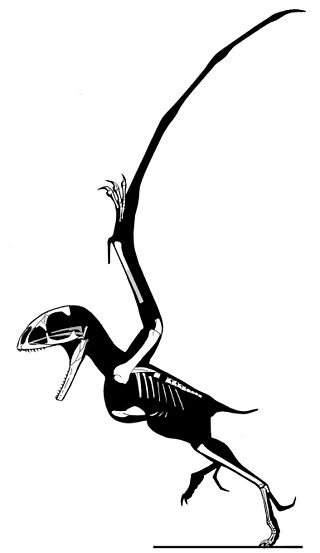
Batrachognathus is an extinct genus of anurognathid pterosaur from the Late Jurassic Karabastau Formation of the central Asian republic of Kazakhstan. The genus was named in 1948 by the Russian paleontologist Anatoly Nicolaevich Ryabinin. The type species is Batrachognathus volans. The genus name is derived from Greek batrakhos, "frog" and gnathos, "jaw", in reference to the short wide head. The specific epithet means "flying" in Latin.
The Zigua or in some sources Zigula are a Bantu ethnic and linguistic people hailing from far northern Pwani Region and western southern Tanga Region in Tanzania. In Tanga Region they are the majority in Handeni District, northern Kilindi District and also are a historically significant population south of the Pangani River in Pangani District. They speak the Zigula language. In 1993, the Zigua population was estimated to number 355,000 people, today they number 631,000 people.

The Shambaa people, also called the Sambaa, Shambala, Sambala or Sambara, are a Bantu ethnic group. Their ancestral home is on the Usambara Mountains of Lushoto District, Korogwe District and Bumbuli District. They are native to the valleys and eastern Usambara Mountains of Korogwe District, Korogwe Urban District and western Muheza District of northern Tanga Region of Tanzania. The word Shamba means "farm", and these people live in one of the most fertile Tanzanian region. Shambaai in Kisambaa means "where the banana's thrive". In 2001, the Shambaa population was estimated to number 664,000.
The Bondei People are a Bantu ethnic group based in Muheza District and Pangani District of eastern Tanga Region in Tanzania. The Bondei speak Kibondei, Bantu language and are culturally related to the Shambaa ethnic group.
G24 may refer to:

Pangani is a historic town and capital of Pangani District in the Tanga Region of Tanzania. The town lies 45 km (28 mi) south of the city of Tanga, at the mouth of the Pangani River in which the town is named after. Administrately the town Pangani is situated within two wards, Pangani Mashariki and Pangani Magharibi. The town is currently the largest settlement in Pangani District and is a major tourist attraction in Tanga region and is a home to Muhembo, a Tanzanian National Historic Site.
The Northeast Coast Bantu languages are the Bantu languages spoken along the coast of Tanzania and Kenya, and including inland Tanzania as far as Dodoma. In Guthrie's geographic classification, they fall within Bantu zones G and E.
Erasto Andrew Mbwana Mang'enya was a Tanganyikan/Tanzanian diplomat and politician.
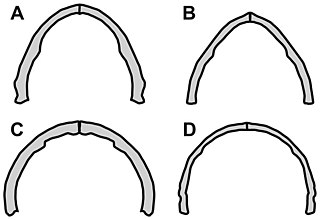
Vesperopterylus is a genus of anurognathid pterosaur from the Early Cretaceous Jiufotang Formation of China, the geologically youngest member of its group. Notably, Vesperopterylus appears to have a reversed first toe, which would have been suited for gripping; it was likely arboreal, climbing or clinging to tree branches with curved, sharp claws. It also has a relatively short tail, in contrast with its tailless (Jeholopterus) and long-tailed (Dendrorhynchoides) relatives. It was first described and named by Lü Junchang et al. While the original spelling of the name was Versperopterylus, this was a typo, and was emended by the authors in accordance with the International Code of Zoological Nomenclature.
Luopterus is an extinct genus of anurognathid pterosaur containing only the holotype species L. mutoudengensis that is known from the Middle Jurassic Tiaojishan Formation of Qinglong, northern Hebei Province, China. It was originally named as a species of Dendrorhynchoides in 2012 but it was moved to the genus Luopterus in 2020. Luopterus was originally thought to be from the Early Cretaceous, with a wingspan that is about 40 centimeters (16 in), making it one of the smallest known pterosaurs.
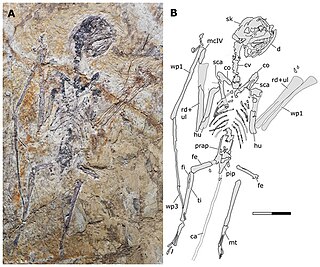
Sinomacrops is a genus of extinct anurognathid pterosaur from the Middle to Late Jurassic periods of what is now the Daohugou Beds of the Tiaojishan Formation in Mutoudeng, Qinglong County of the Hebei province. The remains of Sinomacrops date back to around 164 to 158 million years ago. The type and only known species is Sinomacrops bondei.

Amani is an administrative ward in Muheza District of Tanga Region in Tanzania. Mbomole and Msalai form the ward's northern boundary. Kisiwani is to the east, and Potwe lies to the south. Kwagunda of Korogwe is the western boundary of the ward. The ward is home to the famous Amani Forest Nature Reserve. The ward covers an area of 91 km2 (35 sq mi), and has an average elevation of 963 m (3,159 ft). According to the 2012 census, the ward has a total population of 5,553.

Kisiwani is an administrative ward in Muheza District of Tanga Region in Tanzania. Zirai forms the ward's northern boundary. Tongwe and Misozwe are to the east. Bwembwera and Potwe are to the south. Misalai and Amani form the western boundary of the ward. The ward covers an area of 74.5 km2 (28.8 sq mi), and has an average elevation of 304 m (997 ft). According to the 2012 census, the ward has a total population of 7,123.
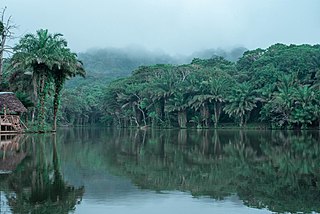
Magoroto is an administrative ward in Muheza District of Tanga Region in Tanzania. Misozwe encircles the ward on its northern border. Kicheba is to the east. Magila and Nkumba are to the south. Tongwe encircles the ward on its western side. The ward covers an area of 38 km2 (15 sq mi), and has an average elevation of 309 m (1,014 ft). According to the 2012 census, the ward has a total population of 5,769.
References
- ↑ Bondei at Ethnologue (18th ed., 2015) (subscription required)
- ↑ Jouni Filip Maho, 2009. New Updated Guthrie List Online